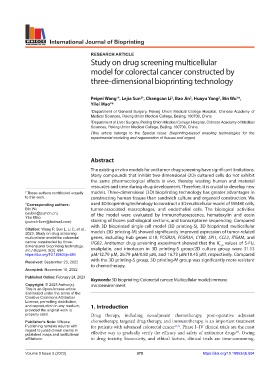Page 387 - IJB-9-3
P. 387
International Journal of Bioprinting
RESEARCH ARTICLE
Study on drug screening multicellular
model for colorectal cancer constructed by
three-dimensional bioprinting technology
2
1
2
2
Peipei Wang , Lejia Sun , Changcan Li , Bao Jin , Huayu Yang , Bin Wu *,
1†
2†
2
Yilei Mao *
1 Department of General Surgery, Peking Union Medical College Hospital, Chinese Academy of
Medical Sciences, Peking Union Medical College, Beijing, 100730, China
2 Department of Liver Surgery, Peking Union Medical College Hospital, Chinese Academy of Medical
Sciences, Peking Union Medical College, Beijing, 100730, China
(This article belongs to the Special Issue: Bioprinting-based enabling technologies for the
experimental modeling and regeneration of tissues and organ)
Abstract
The existing in vitro models for antitumor drug screening have significant limitations.
Many compounds that inhibit two-dimensional (2D) cultured cells do not exhibit
the same pharmacological effects in vivo, thereby wasting human and material
resources and time during drug development. Therefore, it is crucial to develop new
† These authors contributed equally models. Three-dimensional (3D) bioprinting technology has greater advantages in
to this work. constructing human tissues than sandwich culture and organoid construction. We
*Corresponding authors: used 3D bioprinting technology to construct a 3D multicellular model of SW480 cells,
Bin Wu tumor-associated macrophages, and endothelial cells. The biological activities
(wubin@pumch.cn) of the model were evaluated by immunofluorescence, hematoxylin and eosin
Yilei Mao
(pumch-liver@hotmail.com) staining of frozen pathological sections, and transcriptome sequencing. Compared
with 3D bioprinted single-cell model (3D printing-S), 3D bioprinted multicellular
Citation: Wang P, Sun L, Li C, et al.,
2023, Study on drug screening models (3D printing-M) showed significantly improved expression of tumor-related
multicellular model for colorectal genes, including hub genes IL1B, FCGR2A, FCGR3A, CYBB, SPI1, CCL2, ITGAM, and
cancer constructed by three- ITGB2. Antitumor drug screening experiment showed that the IC values of 5-FU,
dimensional bioprinting technology. 50
Int J Bioprint, 9(3): 694. oxaliplatin, and irinotecan in 3D printing-S group/2D culture group were 31.13
https://doi.org/10.18063/ijb.694 µM/12.79 µM, 26.79 µM/0.80 µM, and 16.73 µM/10.45 µM, respectively. Compared
Received: September 23, 2022 with the 3D printing-S group, 3D printing-M group was significantly more resistant
to chemotherapy.
Accepted: November 16, 2022
Published Online: February 24, 2023
Keywords: 3D bioprinting; Colorectal cancer; Multicellular model; Immune
Copyright: © 2023 Author(s). microenvironment
This is an Open Access article
distributed under the terms of the
Creative Commons Attribution
License, permitting distribution,
and reproduction in any medium, 1. Introduction
provided the original work is
properly cited. Drug therapy, including neoadjuvant chemotherapy, post-operative adjuvant
Publisher’s Note: Whioce chemotherapy, targeted drug therapy, and immunotherapy, is an important treatment
Publishing remains neutral with for patients with advanced colorectal cancer [1,2] . Phase I–IV clinical trials are the most
regard to jurisdictional claims in [3]
published maps and institutional effective way to gradually verify the efficacy and safety of antitumor drugs . Owing
affiliations. to drug toxicity, biosecurity, and ethical factors, clinical trials are time-consuming,
Volume 9 Issue 3 (2023) 379 https://doi.org/10.18063/ijb.694

